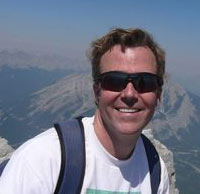
Two summers ago I rode a bicycle across America (Martin’s Ride to Cure Cancer). As you might imagine, there were times when life was at risk. But the most dangerous moment wasn’t on a bicycle. To add another irony, earlier in our most dangerous day, we (I had hired a team of two to help Martin’s Ride make it to the Santa Monica Pier after leaving from the Duke Cancer Institute) were wondering what it would be like to drive on one of these steep mountain roads during a driving rainstorm.
We weren’t RV pros. It had been a long day. We didn’t notice when all the RV pros pulled off the road. Suddenly and quietly, all the cutouts were full. We did notice a quickly darkening sky as we climbed up to 6,000 and then 7,000 feet.
One moment we could see, and the next we couldn’t . Rain came down so hard it laughed at the RV’s wipers even on the highest speed. Conversation died. Lightning struck on our right. My head jerked to look outside at the sound and flash. Turning back, I saw our driver Jeremy’s eyes hadn’t left the road. His concentration was immense. We weren’t going very fast, but it felt more precarious than 100 mph in our thirty foot long rented RV. The mountain was one lane over to our left. It became alive with water. Little rivers formed. Water washed rocks into the road. No one spoke. There was no choice now. We had to drive on.
Later I would think about the irony of riding several thousand miles on a bicycle, risking life and limb coming down mountains at over 60 mph, to possibly die in an RV rolling down God’s Grand Staircase. But in that moment irony was in the future. All we could do was hope and concentrate. After twenty tense minutes, the rain lessened. Jeremy said, “Will someone please say SOMETHING?” We laughed the BIG LAUGH of people glad to be alive driving down to the world’s most beautiful basement.
Expion’s Journey Toward “Social Business” – Summit Day 2
The second day of Expion’s Social Business Summit reminded me of Martin’s Ride’s perilous drive into God’s basement. Every Internet marketing team knows the feeling of fear and dislocation the web creates. Some smart Internet marketers have pulled into the RV cutouts to wait out our current storm, while others must drive on. Any marketing takes courage, focus and concentration. Driving in a lightning storm above 7,000 feet on a tiny road with a sheer drop takes the courage of persistence, a student’s humble approach, and great teachers.
Yesterday’s summary of Expion’s Summit Day One planted the need to create awesome “holy smokes” content into concrete, into the foundation of a new kind of marketing. Few can doubt days of making money from average anything are gone. Day two exposed two other important pillars for creating social business platforms: Storytelling and Mobile.
Peter Heffring, Expion CEO, Demonstrates Expion’s New UI

Enterprise social media seems like an oxymoron. Q: Social media is so hyper-local, how can it also be “enterprise”? A: It can’t. Social media, to be effectively used by a large multi-location company, has to have the right mix of command and control. Too much command from a Big Brother source, and an enterprise just looks stupid and solipsistic on social media. Too little control, and an enterprise’s social media volatility index goes through the roof.
I’ve worked for Fortune 100 companies. One thing they don’t tolerate is volatility beyond their ability to hedge. The truth of most large companies is THEY ARE ALREADY RICH. My father, a “pension plan manager” for wealthy individuals, made a good living hedging natural forces that tear wealth apart (taxes, bad investments, death, divorce).
My father’s clients were already RICH. Their goal was to never be POOR. The slow adoption of social media by larger companies was strange to me until I thought about my father’s career. My former employers P&G and M&M/Mars must hedge. Until Expion created the concept of “enterprise social media”, social media looked like a wild tumble down the Grand Staircase in an RV from the perspective of a large businesse.
Even the most risk adverse BIG COMPANY can understand how to use a tool to hedge, to move forward with “enterprise social media”. When I worked at M&M/Mars, there were years when the commodity trading desk made more money than the rest of the company by trading cocoa futures. Big companies understand how to hedge. Hedging is one of the things that made them big in the first place. Now you see why I KNOW Peter Heffring is a genius. Peter and a very talented team have created a new trading desk – an enterprise social media trading desk. Large, multi-location enterprises use Expion to hedge social media risk. Well done and brilliant.
Storytelling and Mobile
Expion’s Social Business Summit helps us start to see the three-legged stool of the new marketing: awesome content, shared as stories, across any device at any time. This is not to say traditional business values and practices don’t apply. Valuing customers in new and innovative ways, providing outstanding customer service, being relevant and creative aren’t LESS important, nor is social media marketing MORE important. Traditional marketing and sales are table stakes to play the new social storytelling mobile poker.
Social media means you are only as strong as your weakest social link, and your systems, your defenses, are probed 24/7/365. Welcome to the new marketing.
Expion Social Business Summit Summary
The link above is to an excellent summary of every Expion Social Business Summit presentation on Expion’s blog. Matt Wurst (@MWurst), Director Brand Strategy and Emerging Media at 360i, made a great presentation. Matt’s career started in sports marketing, and you can tell he is having fun. Q: How do you get mega sports stars to listen to your marketing ideas? A: Be very good, and have a coach’s enthusiasm.

.
.
.
I kidded Matt on a tweet that his presentation included many “Tweetable Moments”. Here are some of those “Tweetable
Moments”:
- Content is currency.
- Content’s purpose is the creation of a tribe of fans, supporters and advocates.
- Understand your audience by listening at least as carefully as you are speaking.
- Content marketing is the convergence of creative, community and promotion.
- If you are not combining earned and paid media, you can’t win.
- Be a good storyteller.
- Connect O2O (online to offline and vice versa).
- Live in Real Time, and realize marketing is 24/7/365 and “always on” now.
- Content and content marketing are evolving.
I could write a thousand words (our current word count if you are stalwart enough to still be reading this post) on each of these ideas. My favorite idea is the combination of earned and paid media. Matt’s forcefully stated idea plays to one of my favorite themes – Marketing is a tapestry weaving seemingly disparate elements into a beautiful quilt. The new marketing is rarely an “either/or” decision.
Just before the summit, an Atlantic BT customer asked me if he should be using Twitter OR Facebook. There is no OR anymore, as Matt’s presentation artfully implied. Tapestries need every warp and weft to make cohesive sense, to be strong and beautiful. I understand the locus of the question. The desire behind the question was to lighten the load, to do one thing less instead of one more thing. Sorry, I had to explain, Facebook does different things than Twitter. Facebook AND Twitter are more powerful than Facebook alone. The marketing tapestry we weave depends on “awesomeness”, as various speakers explained, and that need only grows.
Regular readers of my posts here and on ScentTrail Marketing will recognize my Internet marketing secret: More and more, faster and faster, better and better. Matt’s presentation reinforced yet another favorite theme – the need to become a great content creator, a great tapestry weaver. Matt’s focus is on being a great marketer, NOT on being a power Facebook or Twitter user. It is easy to get lost. It is easy to focus on the wrong thing, such as becoming a power “X tool” user. Becoming a power user of Facebook, Twitter or Scoop.it doesn’t HURT, unless attaining such expertise distracts from becoming a better marketer. There is an old cliché that if you have a hammer everything looks like a nail.
This kind of “hammer/nail” prejudice can be expensive in the storytelling, mobile and content-is-king, evolving environment Matt described. Any prejudice is expensive, but seeing the world as full of nails when it is in fact full of zebras, elephants, screws and drills creates the kind of blindside risk prejudice-free competitors love to exploit. Writing that last sentence, I realize why I love tools such as Expion.
The right tool, used at the right time, wipes away ego and prejudice. Once data is visualized, many manifest truths become clear. I’ve only ever “created” one website, FoundObjects.com, in 1999 (now RIP). People’s desires expressed via data told me and the teams I’ve managed what to do from there on, across the hundreds of sites we’ve created. That statement is only a little hyperbolic. In this brave new awesome storytelling delivered to a mobile device to a constant demand audience marketing world, the thing that keeps us from tumbling down God’s Grand Staircase is courage and faith, faith and courage. Both faith and courage were on display in abundance at the first, and what I hope will be annual, Expion Social Business Summit.
Thanks to Peter and the Expion team.
Further Reading
My notes from Expion Social Business Summit Day One.
Expion’s blog has several excellent summaries of the summit including:
Master Summary: http://www.expion.com/2012/09/racing-ahead-2012-thank-you-for-an-amazing-social-business-summit/
Jeremiah Owyang’s Keynote Summary
Highly Recommended – Content is the Currency in Social Business (Content: The Social Atom) by Owyang
Following social media thought leader Jeremiah Owyang, also highly recommend: @jowyang
Big Brand Strategies from Coca Cola and H&R Block
Highly Recommended: Coca-Cola: Expressions Are More Valuable than Impressions, presented by Laura Ruff.
***
I apologize for being a day late on this post. My Twitter analysis is sitting in my brain, not on paper yet too. My first cuts at the Expion Social Summit tweet data from TweetReach are interesting, so stay tuned over the weekend as I attempt to catch up. Thanks again to the Expion team for a great event and including their web developers (us). – Marty






